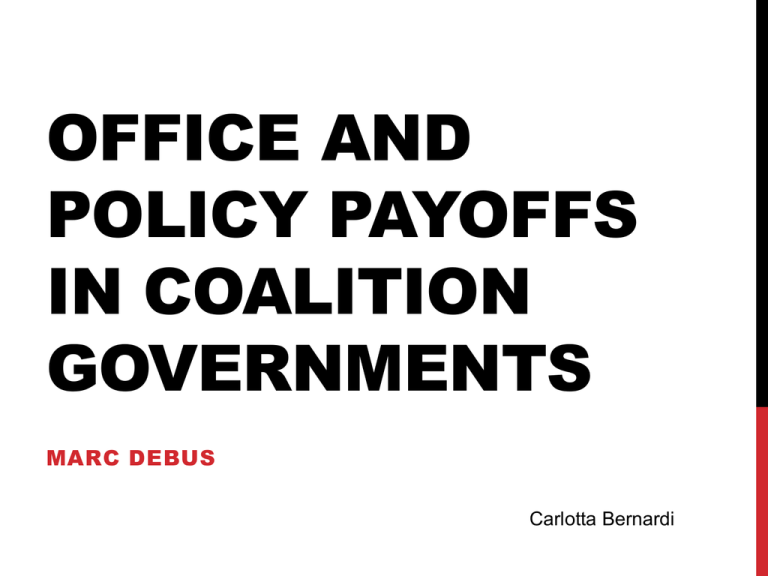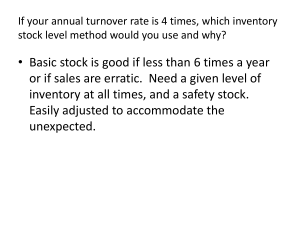Government turnover
advertisement

OFFICE AND POLICY PAYOFFS IN COALITION GOVERNMENTS MARC DEBUS Carlotta Bernardi SUMMARY: Debus uses two models to identify the key parties in the coalition game: 1. the PORTFOLIO ALLOCATION (Laver and Shepsle) 2. and the POLITICAL HEART MODEL (Schofield) He then modifies both models to incorporate political and institutional constrains on coalition formation, and compares the predictions from the four models with the governments that actually formed in five European countries (Austria, Belgium, Germany, Ireland and the Netherlands). • What he finds is that his ‘modified models’ better predict the outcomes than the original ones. PELEG’S DOMINANT PLAYER The dominant player in a political game should became member of a government: • because of his seat strength in parliament; • In addition , if it is centrally located w.r.t. the other parties, it holds a pivotal position. Debus combines this theory with his ‘modified models’ of portfolio allocation and political heart to define (two different) key players in the coalition game: this allows him to make predictions on • Coalition formation • Payoff structure in coalition governments WHAT THESE TWO MODELS SAY? 1. PORTFOLIO ALLOCATION MODEL: • office-oriented approach parties care about office; • stresses importance on the share of cabinet offices held by each party, because cabinet ministers have considerable influence over governmental decision-making in their area of jurisdiction: • the party that holds a portfolio actually sets its policy. • Identification of strong parties. Basically what this model predicts is that a strong party should be able to gain a surpassing share of cabinet offices, and, therefore, should be the key player. WHAT THESE TWO MODELS SAY? 2. POLITICAL HEART MODEL: • policy-oriented approaches • Takes into account both the seat strength of parties in parliament and their programmatic positions • Stresses importance on the policy implementation of key actors • It differentiates between dominant and peripheral parties in the coalition game parties care about policies Key coalition game players implement their policy views better than their coalition partners. DEBUS’ MODIFIED MODEL • Debus adds to the office and policy aspects a BEHAVIORIST and INSTITUTIONAL aspect in order to analyse coalition politics third term of Debus’ modified model • Examples: pre-electoral alliances or potential future coalitions that are rejected a priori by some parties. • What is the effect on the two models? 1. Portfolio allocation model: you can exclude those cabinets that are not feasible. 2. Political heart model: not every proto-coalition located on one median line has the same probability of becoming the future government coalition deep effect: if we some coalitions are precluded, the heart solution becomes unstable or it may even break down into a ‘modified core solution’. CASE SELECTION AND METHOD Debus studies the government formation of five countries in different periods of time: • Austria (1983-2002), • Belgium (1985-2003), • Ireland (1982-2002), • Germany (1980-2005), • The Netherlands (1977-2003). Why? • At least one of them has a unipolar, bipolar or multipolar party system variation in patterns of party competition; • A priori coalition statement or rejection of alliances are common; CASE SELECTION AND STUDIES: To evaluate if a strong party exists in these countries, Debus uses two dimensions: 1. the conflicts in economic and social policy (on which the ideological party competition is based), 2. Plus a country specific third dimension: • • • Foreign policy for Austria, Germany and The Netherlands The conflict over decentralization for Belgium The debate on the status of Northern Ireland in Ireland Debus analyses himself policy documents. • In the case of parties he refers to their election manifestos • To estimate the position of the coalition governments he takes in consideration coalition agreements FINDINGS 1. Estimating key players with the modified portfolio allocation model (strong party concept) does not generally perform well in explanatory terms. 2. By contrast, the modified heart solution not only always identifies a key player, it also delivers more correct predictions w.r.t. the outcome of the coalition game. • In 15 cases where one median line remains stable, the two parties on that median line formed the next government. • If we have only one political actor , as in the case of the remaining 24 cases, the respective party also became a member of the next (coalition) government. CONCLUSIONS: What are the implications of a key player status for the office and policy payoff structure? • Parties that are key players should be able to win a surpassing share of offices - their share of captured cabinet portfolios should be larger than their share of seats inside the coalition government’s majority parliament. • • But from the analysis of the data, key players were not able to do it! The key player should be closer to the programmatic position mentioned in the coalition agreement than the remaining coalition parties are; ergo, key players should be able to better implement their policies. • The data show that key players received the highest policy payoffs!! CONCLUSIONS: • The modified strong party concept: • allows only for predictions whether a strong party exists (28 out of 39 cases) • this party did not always become a member of the next government. • The modified heart solution: • enables estimation of the composition of the next government in all cases • and it predicts the partisan structure of the future (coalition) government in all cases. CONCLUSIONS: There is another implication worth noting: • Coalition agreements should reflect the policy goals of the parties • However, when we look at the weighted Euclidean distances between the positions of the individual governing parties and the coalition agreements, we see that agreements in some cases are not close to any of the parties. • Why? Debus suggests that probably also macroeconomic conditions matter and, thus, coalition agreement’s should mirror also this aspect it is not always possible to change the status quo into one preferred by themselves!! GOVERNMENT TURNOVER CONCEPTS, MEASURES AND APPLICATIONS FRANCESCA UNGARELLI FEATURES OF TURNOVER Is a basic source of variation in institutions and policies across democracies and autocracies with different intensity The frequency and character of turnover depend on: • Voter preferences • Political institutions • Salient events and issues TURNOVER AND ECONOMIC IMPACT What impact might governement turnover have on economic institutions and policies? 2 cases: -Short-lived governments: risk associated with a new government coming to power -Long-lived governments: incentive to implement a broader range of corrupt policies THE CREATION OF MARKET INSTITUTIONS: THE ‘STRONGMAN IDEA’: A dictator who sweeps away the failed past system and imposes basic market institutions: • New, istitutionalized system that survives the passing of the dictator • (e.g Postwar Japan and Germany) WEAK LINK: Benevolence of the dictator THE CREATION OF MARKET INSTITUTION (II) REGULAR TURNOVER OF GOVERNMENTS (When political competition may generate consensus in favour of market institutions): 2 cases of costraints for Turnover’s benefits: Under democracy: • Unpredictability leads the need to appeal to the Median Voter (no benefits to interest groups) Under autocracy: • Economic cost of discontinuity is contingent upon the policies pursued if a given authoritarian government is able to remain in power • Quality-based frequent turnover may be more likely to disrupt the development of market institutions CONCEPTS OF TURNOVER IDEOLOGICAL VS LEADERSHIP: Change in the rules’ ideology Change in rules • The number of relevant ideological turnovers always < or = to the number of leadership turnover • Not all ideological turnover are expected to have an equal effect (i.e. magnitude and direction to be considered) MEASUREMENTS OF TURNOVER LEADERSHIP TURNOVER How is turnover to be measured in legislative institutions? • Change in the istitutional parties that form a majority coalition • Total change in the composition of a party leadership MEASUREMENTS OF TURNOVER (II) How to measure leadership turnover including executives with veto power? • Count turnover only once it occurs in all the legislature institutions • Count and code turnover as fractional alternation • anyway A complete leadership turnover would be required to make a likely substantial impact on the legislative status quo MEASUREMENTS OF TURNOVER (III) IDEOLOGICAL TURNOVER: • Ideological difference needs to be measured • Choice of treshold distance of change to count ideological turnovers when occurring • Judgment of the size of the change according on the dependent variable examined (POLICY OUTCOME) MEASUREMENTS OF TURNOVER (IV) TIME SPAN OF MEASURING TURNOVER: • Consistent with the hypotesized impact of turnover on the outcome of interest • Measure of cumulative turnover: simplest approach in a cross-sectional research design A RESEARCH ANALYSIS Turnover analysis in 28 post- communist countries, from the system changes of 1989–1991 through 2005. First area of discussion: Leadership and Idelogical alternation Tresholds : 1) More than a bare majority of the coalition must be new to count as a leadership turnover 2) Do not impose for turnover a totally new coalition (i.e to include minority party form old coalitions) A RESEARCH ANALYSIS (II) Measure of IDEOLOGICAL DISTANCE: • two-dimensional ideological space • four discrete intervals along each dimension ECONOMIC POLICY Far left, Centre-Left, Far Right, Centre-right Depending on: Level of support for transition to a market economy and for social welfare services NATIONAL IDENTITY Extreme nationalist, moderate nationalist, moderate autonomist, secessionist Depending on: Their positions on minority rights and on relations with ethnic kin in neighbouring countries. A RESEARCH ANALYSIS: While there is great ideological variation among parties, almost all governments have fallen into 3 out of the 16 possible categories: • Far left and moderate nationalist, • Centre-left and moderate nationalist • Centre-right and moderate nationalist. HOW TURNOVER AFFECTS DEVELOPMENT OF THE RULE OF LAW Rule of law prevails when laws are made and enforced so as to treat all individuals, firms, civil society organisations and other legal acorts EQUALLY. It is CORRUPTED to the extent actors are able to use political influence to have laws applied and interpreted on an ad hoc basis to suit their interests. I) HOW WOULD TURNOVER OF GOVERNMENTS BE EXPECTED TO AFFECT THE RULE OF LAW? Turnover of governments would be expected to disrupt longterm corruption contracts Long-term special deals between economic actors and governemnt Increse economic actors’ incentive to ask for general rules rather than special deals. More frequent government turnover in the past will lead acotrs to expect more frequent turnover in the future, which will make corruption contracts less valuable. II) MIGHT VERY FREQUENT TURNOVER AT SOME POINT EVEN INCREASE CORRUPTION? We would expect more frequent government turnovers: •To INCREASE corruption when combined with deviations from market-based legal and security regimes and weak prospects of regaining lost power and influence •To REDUCE corruption when government turnover takes place within market-based legal and security regimes III) WOULD CORRUPTION-REDUCING EFFECTS OF TURNOVER BE EXPECTED TO BE SIMILAR IN ALL POLITICAL CONTEXTS? Transitional political systems Established political systems Are more likely to be reshaping judicial, law enforcement and regulatory institutions It is more likely that judicial, law enforcment and regulatory institutions will develop indipendently of serving goverments More frequent turnover should disrupt a wider range of corruptions opportunities, greater impact Turnover will affect a narrower range of corruption opportunities, and should have less impact POST-COMMUNIST COUNTRIES •Hypothesis: Increased government turnover should reduce gains from investment in influence, and hence contribute to development of a more neutral rule of law •Measure: Cumulative measure, as additional turnovers should further reduce expected gains from investing in influence •Expectation: Ideological turnover has a greater effect than leadership turnover LEADERSHIP TURNOVER IDEOLOGICAL TURNOVER LEVEL OF RULE OF LAW COMPARATIVE POLITICAL DATA SETS Comparative Political Data Set I • 1960-2009 • research projects “Die Handlungs-spielräume des Nationalstaates“ and “Critical junctures”,Klaus Armingeon • 23 democratic countries • demographic, socioand economic variables • for cross national, longitudinal and pooled time series analyses Comparative Political Data Set II • 1989-2007 • research project “Forms of Government”,Klaus Armingeon • 28 Post Communist Countries • demographic, and socio-economic variables Comparative Political Data Set III • 1990-2009 • 35 OECD Countries and/or EU-member countries • different operationalisation for some of the institutional variables • data are drawn from two data sets I and II • the cabinet composition (right-centre-left) was calculated both as a percentage of parliamentary seats and as a percentage of cabinet positions SOME MAIN VARIABLES DATA SET I.pdf DATA SET II.pdf DATA SET III.pdf






